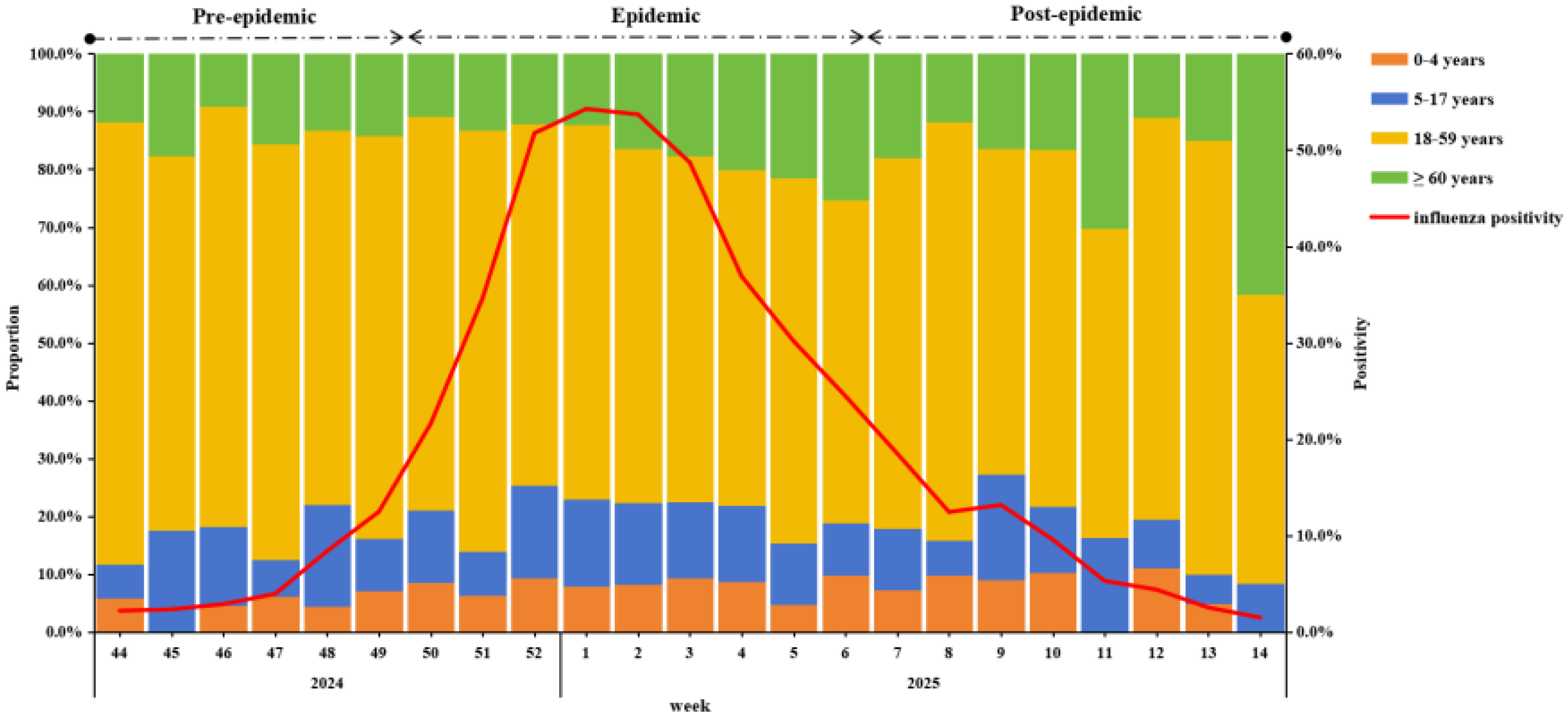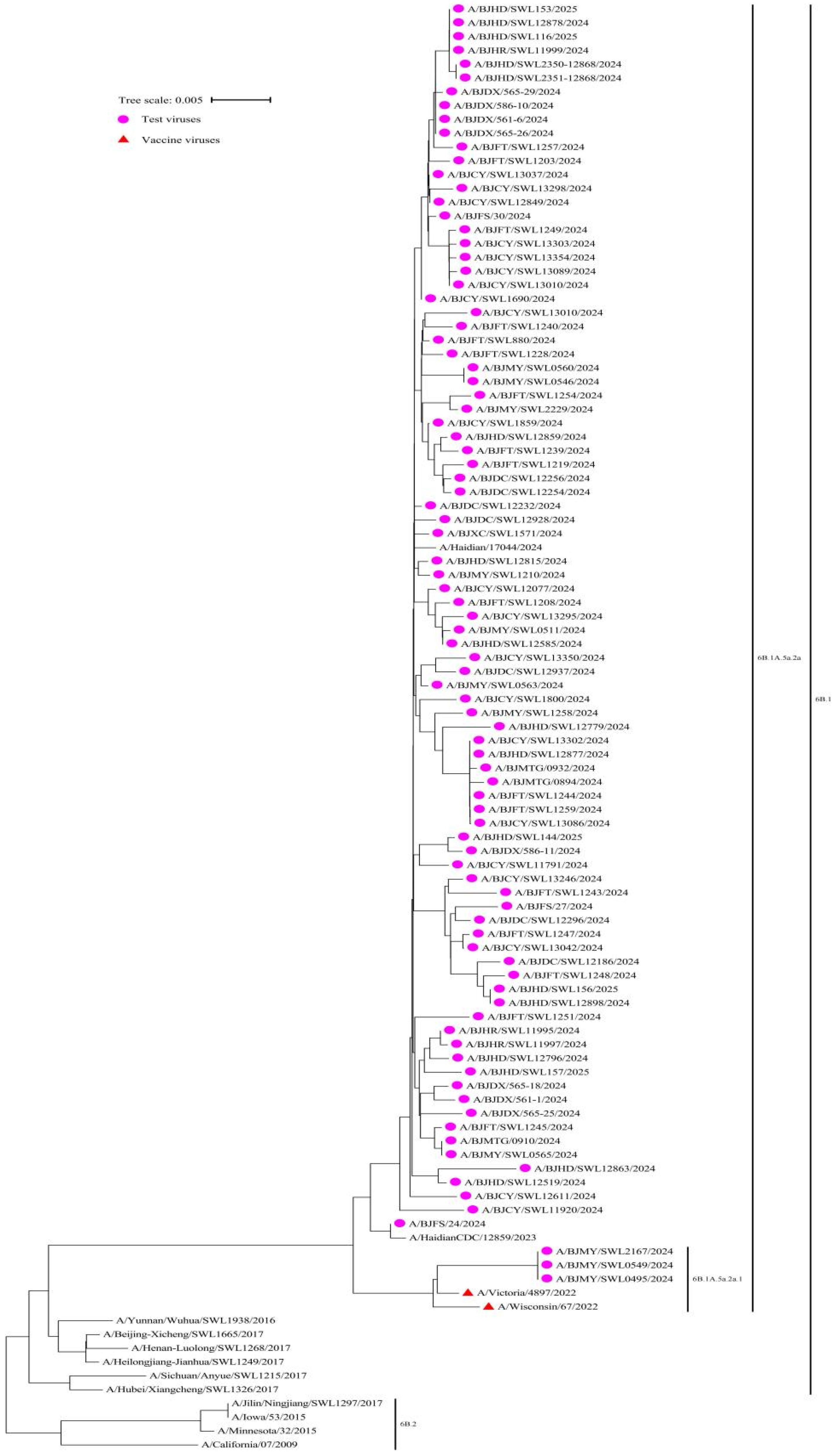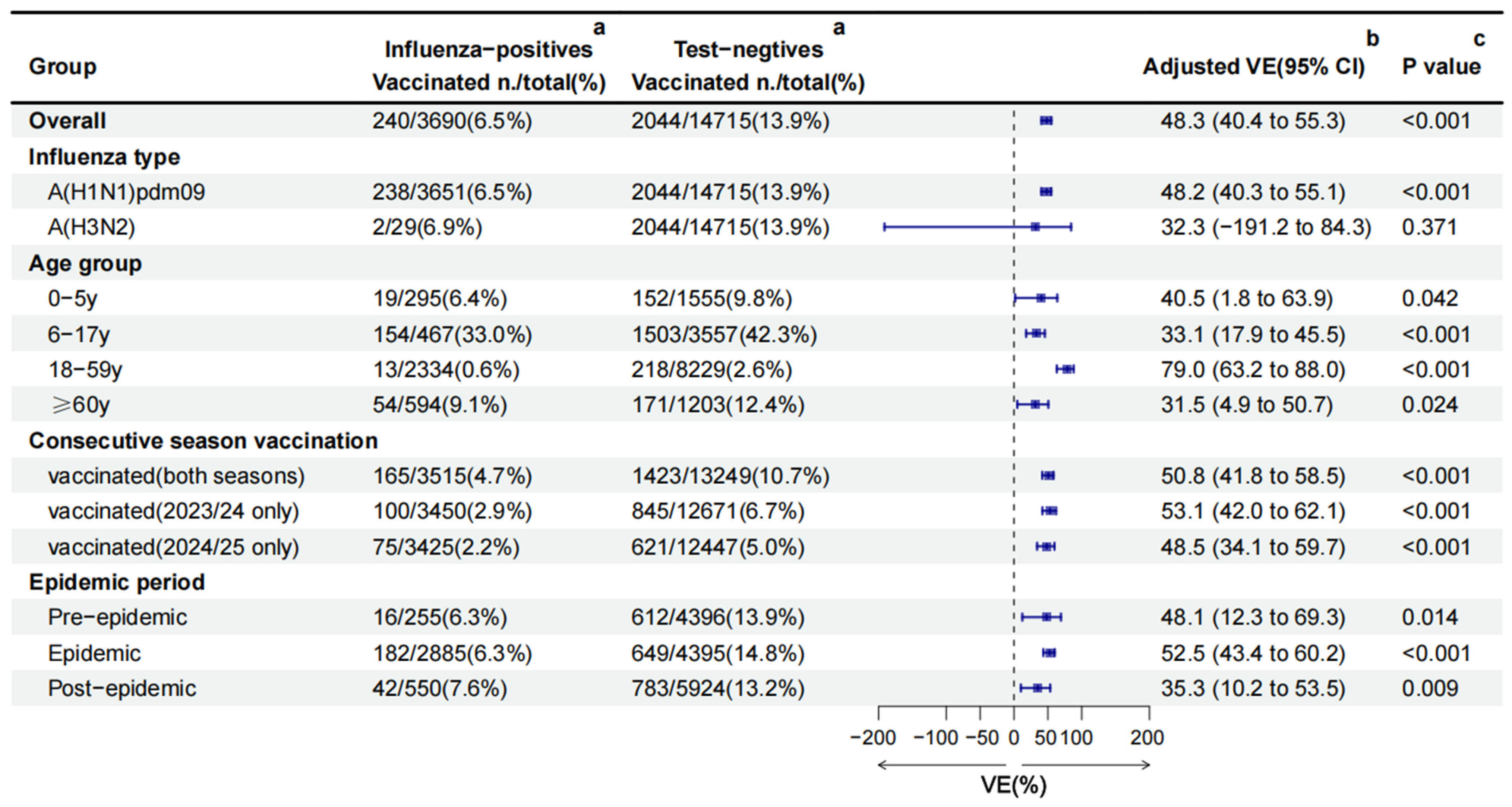End-of-Season Influenza Vaccine Effectiveness Against Laboratory-Confirmed Influenza in Outpatient Settings, Beijing, China: A Test-Negative Design
Abstract
1. Introduction
2. Materials and Methods
2.1. Subject Enrollment and Laboratory Detection
2.2. Study Design and Data Collection
2.3. Statistical Analysis
3. Results
3.1. Study Population and Influenza Activity in the 2024–2025 Season
3.2. Phylogenetic Analysis
3.3. Influenza Vaccination Coverage and Vaccine Effectiveness Estimates
4. Discussion
5. Conclusions
Supplementary Materials
Author Contributions
Funding
Institutional Review Board Statement
Informed Consent Statement
Data Availability Statement
Acknowledgments
Conflicts of Interest
References
- Shen, Y.; Liu, Y.; Krafft, T.; Wang, Q. Progress and challenges in infectious disease surveillance and early warning. Med. Plus 2025, 2, 100071. [Google Scholar] [CrossRef]
- World Health Organization. Global Influenza Strategy 2019–2030; WHO: Geneva, Switzerland, 2019; Available online: https://www.who.int/publications/i/item/9789241515320 (accessed on 8 May 2025).
- U.S. Centers for Disease Control and Prevention. Flu Burden Prevented from Vaccination 2023–2024 Flu Season. 2025. Available online: https://www.cdc.gov/flu-burden/php/data-vis-vac/2023-2024-prevented.html (accessed on 8 May 2025).
- Moore, K.A.; Ostrowsky, J.T.; Kraigsley, A.M.; Mehr, A.J.; Bresee, J.S.; Friede, M.H.; Gellin, B.G.; Golding, J.P.; Hart, P.J.; Moen, A.; et al. A Research and Development (R&D) roadmap for influenza vaccines: Looking toward the future. Vaccine 2021, 39, 6573–6584. [Google Scholar] [CrossRef]
- Cowling, B.J.; Wong, I.O.; Ho, L.M.; Riley, S.; Leung, G.M. Methods for monitoring influenza surveillance data. Int. J. Epidemiol. 2006, 35, 1314–1321. [Google Scholar] [CrossRef]
- National Immunization Advisory Committee (NIAC); Technical Working Group (TWG). Technical guidelines for seasonal influenza vaccination in China, 2023–2024. Chin. J. Epidemiol. 2023, 44, 1507–1530. [Google Scholar] [CrossRef]
- Zhang, Y.; Muscatello, D.J.; Wang, Q.; Yang, P.; Wu, J.; MacIntyre, C.R. Overview of influenza vaccination policy in Beijing, China: Current status and future prospects. J. Public Health Policy 2017, 38, 366–379. [Google Scholar] [CrossRef] [PubMed]
- Sun, Y.; Shi, W.; Zhang, D.; Ma, C.; Feng, Z.; Zhang, J.; Wu, D.; Zhang, L.; Li, J.; Duan, W.; et al. Early vaccine effectiveness estimates against medically attended laboratory-confirmed influenza based on influenza surveillance, Beijing, China, 2024/25 season. Eurosurveillance 2025, 30, 2500084. [Google Scholar] [CrossRef] [PubMed]
- U.S. Centers for Disease Control and Prevention. Weekly Flu Vaccination Dashboard. 2025. Available online: https://www.cdc.gov/fluvaxview/dashboard/index.html (accessed on 8 May 2025).
- Rose, A.M.; Lucaccioni, H.; Marsh, K.; Kirsebom, F.; Whitaker, H.; Emborg, H.D.; Botnen, A.B.; O’Doherty, M.G.; Pozo, F.; Hameed, S.S.; et al. Interim 2024/25 influenza vaccine effectiveness: Eight European studies, September 2024 to January 2025. Eurosurveillance 2025, 30, 2500102. [Google Scholar] [CrossRef]
- Shen, Y.; Feng, Z.; Zhang, D.; Wang, X.; Sun, Y.; Li, F.; Zhang, L.; Zhang, J.; Ma, C.; Yang, P.; et al. Mitigated transmission and health impact of COVID-19 in Beijing, China during spring 2024: Comparison with the global trends. Sci. Bull. 2024, 69, 3212–3215. [Google Scholar] [CrossRef]
- Frutos, A.M.; Cleary, S.; Reeves, E.L.; Ahmad, H.M.; Price, A.M.; Self, W.H.; Zhu, Y.; Safdar, B.; Peltan, I.D.; Gibbs, K.W.; et al. Interim Estimates of 2024–2025 Seasonal Influenza Vaccine Effectiveness—Four Vaccine Effectiveness Networks, United States, October 2024–February 2025. MMWR Morb. Mortal. Wkly. Rep. 2025, 74, 83–90. [Google Scholar] [CrossRef]
- Separovic, L.; Zhan, Y.; Kaweski, S.E.; Sabaiduc, S.; Carazo, S.; Olsha, R.; Mather, R.G.; Dickinson, J.A.; Hasso, M.; Meunier, I.; et al. Interim estimates of vaccine effectiveness against influenza A(H1N1)pdm09 and A(H3N2) during a delayed influenza season, Canada, 2024/25. Eurosurveillance 2025, 30, 2500059. [Google Scholar] [CrossRef]
- Rajaram, S.; Wojcik, R.; Moore, C.; Ortiz de Lejarazu, R.; de Lusignan, S.; Montomoli, E.; Rossi, A.; Pérez-Rubio, A.; Trilla, A.; Baldo, V.; et al. The impact of candidate influenza virus and egg-based manufacture on vaccine effectiveness: Literature review and expert consensus. Vaccine 2020, 38, 6047–6056. [Google Scholar] [CrossRef]
- Centers for Disease Control (CDC). Weekly US Influenza Surveillance Report: Key Updates for Week 19, Ending May 10, 2025; CDC: Atlanta, GA, USA, 2025. Available online: https://www.cdc.gov/fluview/surveillance/2025-week-19.html (accessed on 8 May 2025).
- Trombetta, C.M.; Kistner, O.; Montomoli, E.; Viviani, S.; Marchi, S. Influenza Viruses and Vaccines: The Role of Vaccine Effectiveness Studies for Evaluation of the Benefits of Influenza Vaccines. Vaccines 2022, 10, 714. [Google Scholar] [CrossRef]
- Okoli, G.N.; Racovitan, F.; Abdulwahid, T.; Righolt, C.H.; Mahmud, S.M. Variable seasonal influenza vaccine effectiveness across geographical regions, age groups and levels of vaccine antigenic similarity with circulating virus strains: A systematic review and meta-analysis of the evidence from test-negative design studies after the 2009/10 influenza pandemic. Vaccine 2021, 39, 1225–1240. [Google Scholar] [CrossRef]
- Belongia, E.A.; Skowronski, D.M.; McLean, H.Q.; Chambers, C.; Sundaram, M.E.; De Serres, G. Repeated annual influenza vaccination and vaccine effectiveness: Review of evidence. Expert Rev. Vaccines 2017, 16, 723–736. [Google Scholar] [CrossRef]
- Bartoszko, J.J.; McNamara, I.F.; Aras, O.A.Z.; Hylton, D.A.; Zhang, Y.B.; Malhotra, D.; Hyett, S.L.; Morassut, R.E.; Rudziak, P.; Loeb, M. Does consecutive influenza vaccination reduce protection against influenza: A systematic review and meta-analysis. Vaccine 2018, 36, 3434–3444. [Google Scholar] [CrossRef] [PubMed]
- Loeb, M.; Russell, M.L.; Moss, L.; Fonseca, K.; Fox, J.; Earn, D.J.; Aoki, F.; Horsman, G.; Van Caeseele, P.; Chokani, K.; et al. Effect of influenza vaccination of children on infection rates in Hutterite communities: A randomized trial. JAMA 2010, 303, 943–950. [Google Scholar] [CrossRef]
- U.S. Centers for Disease Control and Prevention. Immunogenicity, Efficacy, and Effectiveness of Influenza Vaccines. 2025. Available online: https://archive.cdc.gov/www_cdc_gov/flu/professionals/acip/immunogenicity.htm (accessed on 8 May 2025).
- Lewnard, J.A.; Cobey, S. Immune History and Influenza Vaccine Effectiveness. Vaccines 2018, 6, 28. [Google Scholar] [CrossRef] [PubMed]
- Okoli, G.N.; Racovitan, F.; Abdulwahid, T.; Hyder, S.K.; Lansbury, L.; Righolt, C.H.; Mahmud, S.M.; Nguyen-Van-Tam, J.S. Decline in Seasonal Influenza Vaccine Effectiveness With Vaccination Program Maturation: A Systematic Review and Meta-analysis. Open Forum Infect. Dis. 2021, 8, ofab069. [Google Scholar] [CrossRef] [PubMed]
- Grohskopf, L.A.; Ferdinands, J.M.; Blanton, L.H.; Broder, K.R.; Loehr, J. Prevention and Control of Seasonal Influenza with Vaccines: Recommendations of the Advisory Committee on Immunization Practices—United States, 2024–2025 Influenza Season. MMWR Recomm. Rep. 2024, 73, 1–25. [Google Scholar] [CrossRef]
- Bedford, T.; Suchard, M.A.; Lemey, P.; Dudas, G.; Gregory, V.; Hay, A.J.; McCauley, J.W.; Russell, C.A.; Smith, D.J.; Rambaut, A. Integrating influenza antigenic dynamics with molecular evolution. Elife 2014, 3, e01914. [Google Scholar] [CrossRef]
- Doyon-Plourde, P.; Przepiorkowski, J.; Young, K.; Zhao, L.; Sinilaite, A. Intraseasonal waning immunity of seasonal influenza vaccine—A systematic review and meta-analysis. Vaccine 2023, 41, 4462–4471. [Google Scholar] [CrossRef]
- Bouvier, N.M. The Future of Influenza Vaccines: A Historical and Clinical Perspective. Vaccines 2018, 6, 58. [Google Scholar] [CrossRef]
- Beijing Municipal Health Commission. The 2024 Flu Vaccination in Beijing Begins. 2024. Available online: https://wjw.beijing.gov.cn/xwzx_20031/xwfb/202409/t20240912_3865291.html (accessed on 17 July 2025).



| Characteristic | Total, n (%) | Influenza-Positive Case, n (%) | Test-Negative Control, n (%) | p Value # | Vaccinated, n (%) | p Value # |
|---|---|---|---|---|---|---|
| Overall | 18,405 (100.0%) | 3690 (20.0%) | 14,715 (80.0%) | 2284 (12.4%) | ||
| Age group | ||||||
| 0–5 years | 1850 (10.1%) | 295 (15.9%) | 1555 (84.1%) | <0.001 | 171 (9.2%) | <0.001 |
| 6–17 years | 4024 (21.9%) | 467 (11.6%) | 3557 (88.4%) | 1657 (41.2%) | ||
| 18–59 years | 10,563 (57.4%) | 2334 (22.1%) | 8229 (77.9%) | 231 (2.2%) | ||
| ≥60 years | 1968 (10.7%) | 594 (30.2%) | 1374 (69.8%) | 225 (11.4%) | ||
| Sex | ||||||
| Male | 8798 (47.8%) | 1748 (19.9%) | 7050 (80.1%) | 0.558 | 1159 (13.2%) | 0.003 |
| Female | 9607 (52.2%) | 1942 (20.2%) | 7665 (79.8%) | 1125 (11.7%) | ||
| Region * | ||||||
| Urban | 8190 (44.5%) | 1717 (21.0%) | 6473 (79.0%) | <0.001 | 1004 (12.3%) | 0.463 |
| Suburb | 6530 (35.5%) | 1186 (18.2%) | 5344 (81.8%) | 836 (12.8%) | ||
| Exurban | 3685 (20.0%) | 787 (21.4%) | 2898 (78.6%) | 444 (12.0%) | ||
| Chronic diseases | ||||||
| Yes | 1144 (6.2%) | 273 (23.9%) | 871 (76.1%) | 0.001 | 74 (6.5%) | <0.001 |
| No | 17,261 (93.8%) | 3417 (19.8%) | 13,844 (80.2%) | 2210 (12.8%) | ||
| Influenza Status for the 2023/24 Season | ||||||
| Uninfected | 9457 (51.4%) | 1951 (20.6%) | 7506 (79.4%) | 0.127 | 1197 (12.7%) | 0.232 |
| Infection | 283 (1.5%) | 54 (19.1%) | 229 (80.9%) | 27 (9.5%) | ||
| Unclear | 8665 (47.1%) | 1685 (19.4%) | 6980 (80.6%) | 1060 (12.2%) | ||
| Pneumonia | ||||||
| Yes | 912 (5.0%) | 105 (11.5%) | 807 (88.5%) | <0.001 | 104 (11.4%) | 0.344 |
| No | 17,493 (95.0%) | 3585 (20.5%) | 13,908 (79.5%) | 2180 (12.5%) | ||
| Interval between onset and sampling | ||||||
| ≤3 days | 17,531 (95.3%) | 3552 (20.3%) | 13,979 (79.7%) | <0.001 | 2175 (12.4%) | 0.955 |
| 4–7 days | 874 (4.7%) | 138 (15.8%) | 736 (84.2%) | 109 (12.5%) | ||
| Epidemic period | ||||||
| Pre-epidemic | 4651 (25.3%) | 255 (5.5%) | 4396 (94.5%) | <0.001 | 628 (13.5%) | 0.002 |
| Epidemic | 7280 (39.6%) | 2885 (39.6%) | 4395 (60.4%) | 831 (11.4%) | ||
| Post-epidemic | 6474 (35.2%) | 550 (8.5%) | 5924 (91.5%) | 825 (12.7%) | ||
| Consecutive season vaccination | ||||||
| Vaccinated (both seasons) | 1588 (8.6%) | 165 (10.4%) | 1423 (89.6%) | <0.001 | 1588 (100.0%) | - |
| Vaccinated (2023/24 only) | 945 (5.1%) | 100 (10.6%) | 845 (89.4%) | 0 (0.0%) | ||
| Vaccinated (2024/25 only) | 696 (3.8%) | 75 (10.8%) | 621 (89.2%) | 696 (100.0%) | ||
| Unvaccinated (both seasons) | 15,176 (82.5%) | 3350 (22.1%) | 11,826 (77.9%) | 0 (0.0%) |
Disclaimer/Publisher’s Note: The statements, opinions and data contained in all publications are solely those of the individual author(s) and contributor(s) and not of MDPI and/or the editor(s). MDPI and/or the editor(s) disclaim responsibility for any injury to people or property resulting from any ideas, methods, instructions or products referred to in the content. |
© 2025 by the authors. Licensee MDPI, Basel, Switzerland. This article is an open access article distributed under the terms and conditions of the Creative Commons Attribution (CC BY) license (https://creativecommons.org/licenses/by/4.0/).
Share and Cite
Zhang, J.; Feng, Z.; Shen, Y.; Shi, W.; Sun, Y.; Zhao, J.; Wu, D.; Li, J.; Ma, C.; Duan, W.; et al. End-of-Season Influenza Vaccine Effectiveness Against Laboratory-Confirmed Influenza in Outpatient Settings, Beijing, China: A Test-Negative Design. Vaccines 2025, 13, 809. https://doi.org/10.3390/vaccines13080809
Zhang J, Feng Z, Shen Y, Shi W, Sun Y, Zhao J, Wu D, Li J, Ma C, Duan W, et al. End-of-Season Influenza Vaccine Effectiveness Against Laboratory-Confirmed Influenza in Outpatient Settings, Beijing, China: A Test-Negative Design. Vaccines. 2025; 13(8):809. https://doi.org/10.3390/vaccines13080809
Chicago/Turabian StyleZhang, Jiaojiao, Zhaomin Feng, Ying Shen, Weixian Shi, Ying Sun, Jiachen Zhao, Dan Wu, Jia Li, Chunna Ma, Wei Duan, and et al. 2025. "End-of-Season Influenza Vaccine Effectiveness Against Laboratory-Confirmed Influenza in Outpatient Settings, Beijing, China: A Test-Negative Design" Vaccines 13, no. 8: 809. https://doi.org/10.3390/vaccines13080809
APA StyleZhang, J., Feng, Z., Shen, Y., Shi, W., Sun, Y., Zhao, J., Wu, D., Li, J., Ma, C., Duan, W., Ma, J., Wang, Y., Zhang, L., Hu, X., Wang, Q., Zhang, D., & Yang, P. (2025). End-of-Season Influenza Vaccine Effectiveness Against Laboratory-Confirmed Influenza in Outpatient Settings, Beijing, China: A Test-Negative Design. Vaccines, 13(8), 809. https://doi.org/10.3390/vaccines13080809






